Ageratum: description and varieties, planting and care

Unusual fluffy flowers, reminiscent of pompons, adorn the garden plots of many summer residents. This is ageratum. The culture is unpretentious, but its cultivation has its own characteristics. Our article will tell you how to plant this fragrant ornamental plant and how to care for it.
Peculiarities
Ageratum is a flowering herb. It belongs to the Astrov family. In the wild, the flower can be seen in India, Central America. Garden varieties are cultivated in different countries, including Russia.


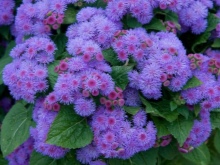
The flowers are small, bisexual. They gather in dense inflorescences. The variety of colors of culture allows flower growers to create spectacular landscape compositions with its help. White, yellow, pink, lilac, blue "caps" look beautiful both in single plantings and in combinations with other colors.
The ageratum has a long flowering period (this explains its other name). Dolgotsvetka pleases with its bright beauty from May to late autumn. If you cut the plants into a bouquet, they will remain fresh and fragrant for a long time in the vase.
The culture is not very high. Flowers grow up to a maximum of 50 cm. The average height is 25 cm. There are also dwarf species. Usually they are chosen for indoor cultivation.
The stems are pubescent. The leaves can be oval, triangle or diamond shaped. The seeds ripen at the end of August.
Also, the culture can be propagated by cuttings.



Annual or perennial?
The description of the culture says that it is perennial. However, in the conditions of central Russia, the flower is grown as an annual. The fact is that the plant cannot survive the winter. No shelter is able to protect a flower planted on a site from frost. Perennial specimens are found only in some greenhouses, where a certain temperature is maintained throughout the year.
Types and varieties
First of all, it is worth highlighting ageratum mexican... It is sometimes called the Houston or Gauston ageratum after the discoverer. This type of culture is the most common. Such flowers grow up to 25 cm. The group includes many varieties that can have a white, blue, purple, pink hue.

"Blue mink" ("Blue mink")
A low-growing variety (up to 25 cm) is compact and strong shoots. As the name implies, the flowers of the plant have a rich blue tone, but there are also delicate lilac flowers. The thin petals of the culture resemble the villi of a fluffy animal. This explains the second part of the name.
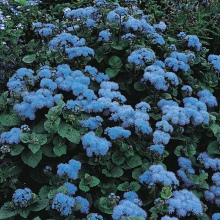

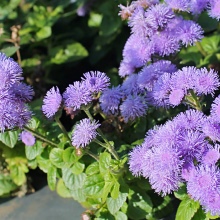
Aloha Blue
This hybrid, despite its name, has lilac flowers. The culture grows up to 20 cm. Like the Mink, this variety blooms in June.

"Alba"
A small 20-centimeter bush is decorated with white flowers. The variety is considered to be late flowering. The buds begin to appear only in July.


Summers Snow (Snowy Summer)
Another snow-white variety. However, unlike the previous one, it is quite high. Bushes can grow up to 45-50 cm. Large flowers give the plant a spectacular look and resemblance to a white cloud.

Red Sea (Red Sea)
A bright variety with purple flowers. Quite an unusual color for this culture. Plant height - 30-45 cm.The stems are powerful, the inflorescences are lush, "shaggy". This variety blooms from May to autumn.
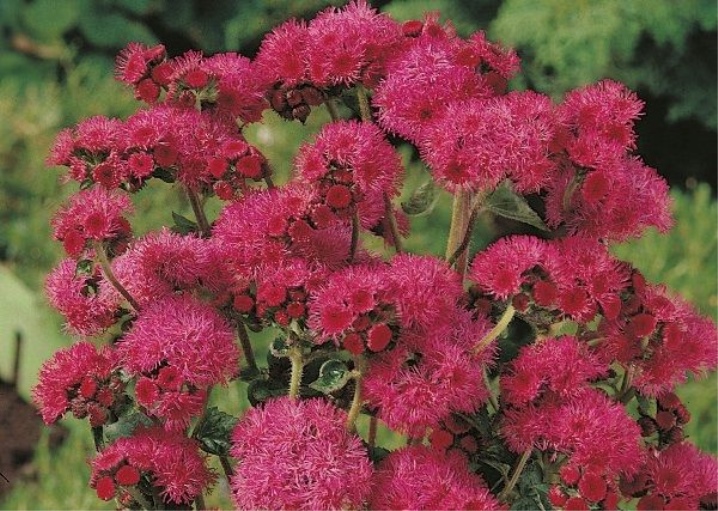
"Pink ball"
Large pink "balls" on a compact plant can transform any area. Flowering begins in mid-June. It lasts until October.

"Cloud Nine"
This series includes plants in three color options: purple, pink and white. Bushes are low, compact (maximum 15 cm). The culture is ideal for both potting and gardening. Flowering begins in early July and lasts for 3 months.



"Cardinal Bordeaux"
Lush burgundy flowers look very impressive against the backdrop of greenery. Bushes grow up to 25 cm, have the shape of a ball. The inflorescences are large, can reach a diameter of 8 cm. The culture blooms profusely and for a long time. Bright buds begin to appear at the end of June and delight with their beauty until late autumn.

Sowing seedlings
To get a beautiful ageratum flower, sowing is first carried out, and only then the grown seedlings are moved to an open area. Sowing is carried out from mid-March to early April.
Fertile soil is poured into the prepared containers. A mixture of sand, peat and humus is perfect. All components are taken in equal proportions. Before the procedure, the soil is sprayed with a spray bottle. Then the seeds are distributed on the surface. They are sprinkled on top with a thin (about 3 mm) layer of soil.
After that, the box is covered with polyethylene. Glass can also be used. The container is left in a room with a temperature of about 22 degrees.
Illumination should be good, although it is better to exclude direct sunlight on the landings.


Periodically, the seedlings are ventilated. It is also important to monitor soil moisture. A spray bottle is used for irrigation.
The first shoots appear in about 2 weeks. When it will be possible to see 2 leaves on young plants, they are seated in separate containers. Flowers are moved to the site when warm spring days come. This is usually mid-May.
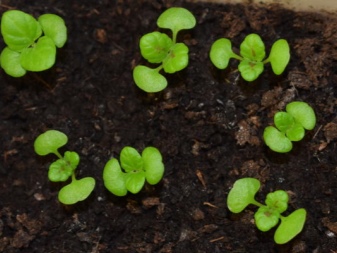

How to plant in open ground?
A couple of weeks before the young flowers are transplanted to the site, they begin to harden. During the day they are taken out into the street, gradually increasing the airing time. Of course, seedlings are protected from rain and sunlight. It is better to choose a plot in the garden that is well lit. In partial shade, the culture will feel good, but flowering in this case will be less lush and longer.

As for the soil, it must be fertile and permeable. The optimum acidity level is neutral. A good solution is to mix leafy soil and peat. It is not worth planting a flower in heavy clay soil.
If several plants are planted (for example, to decorate a border), it is important to maintain a distance between the specimens of about 20 cm. The seedlings are carefully removed from the home container and placed in the wells. Then they are sprinkled with soil and watered abundantly. Flowering can be expected after about a month. The exact timing depends on the variety.


How to take care of it properly?
Watering
Water the culture in moderation. The top layer of the soil should have time to dry out between water treatments.
Excessive moisture can lead to root rot. Therefore, you should not be zealous with this, especially if the summer is rainy.
Top dressing
The soil should remain nutritious and loose throughout the flower's life. It is important to regularly loosen the soil, remove weeds. Fertilize the soil several times a season.

The first feeding is carried out 2 weeks after planting the plant on the site. The second procedure is carried out during the budding period. The third feeding is not necessary, but if the gardener wants to achieve the most lush and long flowering, in the middle of the cycle it is worth feeding the culture again.
Organic fertilizers should be alternated with mineral fertilizers. Potassium-phosphorus compounds are useful for the plant. But products with a high nitrogen content should not be used.This element accelerates the growth of shoots, but at the same time postpones the beginning of flowering of the culture.
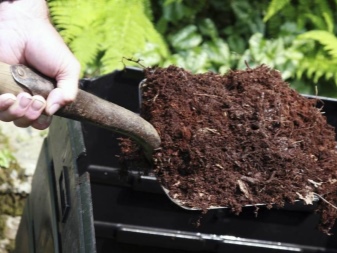

Pruning
Withered buds are recommended to be removed immediately. It is also worth pruning the shoots regularly. The main thing is to leave a few internodes. After this procedure, the bush becomes even more lush and branched.
Wintering
As already mentioned, it will not work to preserve the culture in the open field for the winter. You can only collect seeds for further breeding or use the cuttings method.


Reproduction methods
Seeds
The collection of seeds is carried out immediately after the end of flowering of the bush. The seeds must be collected and placed in a paper bag. Store seed in a cool, dry place.
Cuttings
With the arrival of the first frost, flower bushes are dug up and transferred to home containers. However, it is not worth transferring the plant directly to the apartment. It is recommended to first place the flower on the balcony, where the temperature is higher than outside, but below room temperature. After some time, you can rearrange the ageratum in the apartment. You can also leave it on the balcony.
Re-flowering at home is rare. But the first buds will remain on the bush for a long time. If flowering in the garden ends in the fall, then with the transfer of culture to the house, it can continue until winter.

Cuttings are cut in March. The cut must be oblique. This will increase the further absorption of moisture and valuable substances from the soil by the planting material. First, the cuttings are briefly immersed in a growth stimulant solution. Usually use "Kornevin". Then they are seated in separate small containers.
For good survival, greenhouse conditions are organized. You can cover the containers with foil or use glass. The soil is kept moist. The recommended temperature level is 22 degrees.
Rooting takes place within 2 weeks. When stable warm weather sets in, young plants are moved to open ground. It is advisable to choose a sunny location.
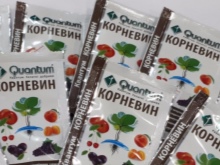


The subtleties of growing at home
The culture is successfully grown not only in the garden, but also indoors. To grow ageratum in a pot, you just need to pick up a spacious container and prepare good drainage. As a primer, you can use a mixture from a specialized store.
It is better to place the pot in the warmest part of the house. Make sure the flower will be well lit. In the summer, it will be possible to take the plant out to the loggia or veranda. If you follow the simple rules of care, then from the beginning of summer days until the New Year, you can enjoy the lush flowering of the culture.
Water the plant at the root. Moisture should not get on the leaves. The best time to irrigate is in the morning. After moistening, it is advisable to gently loosen the soil. This will increase the access of oxygen to the root system of the crop. Fertilizers are recommended to be applied every 5-6 months.
A complex mineral composition is quite suitable for flowering crops.



Diseases and pests
Indoor flowers do not get sick very often, but specimens growing in the garden are more vulnerable to infections and pests.
Root rot
The cause of this trouble may be excess watering. The likelihood of damage to the plant also increases in the rainy season. Outwardly, this is manifested by the wilting of the flower, the loss of leaves and buds. In the ground, the death of the root system occurs.
Unfortunately, such a plant cannot be saved. Damaged specimens are dug up and destroyed. Healthy crops growing nearby are treated with special preparations. Usually use "Fundazol" and "Oxyhom".
To reduce the risk of flower infection, you can take simple measures:
- ensuring good drainage;
- control of the number of irrigations;
- regular procedures for loosening and removing weeds.



Cucumber mosaic
This is an equally dangerous disease. It is also deadly. The virus manifests itself with yellow spots, which increase in size over time. Insects (usually aphids) become carriers of the infection. As the name implies, the disease is typical for cucumbers, so you should not plant flowers next to this culture.
In case of trouble, the plant is dug up and destroyed. The soil and tools that were used in the work are disinfected with bleach. Otherwise, the disease can be transmitted to other plants.


Blackleg
This ailment is expressed by rotting of the lower part of the stem. Lack of sunlight, low temperatures, excess moisture in the soil lead to such a situation. Diseased plants are removed from the garden. Neighboring healthy specimens are sprayed with a manganese solution. The procedure is carried out several times with a break of 1 week.
Necrosis (bacterial wilting)
This disease is also manifested by the wilting of the plant. But in this case, the process starts from the top of the flower. In such a situation, the damaged areas are cut off. Then the plant is sprayed with a copper-containing composition. The soil also needs to be processed.
If the procedure is effective, the flower will gradually recover. If the treatment does not help, the culture is dug up and burned. The soil in which the ageratum grew is spilled with boiling water. Only then does it become suitable for planting other flowers and greenery.
Remember to work with diseased plants with gloves. After the procedure (cutting or digging out), all devices must be treated with alcohol to eliminate the risk of contamination of other crops.


Insect pests
There are several main threats to the ageratum. The first is the spider mite. You can notice its presence by light spots on the foliage of plants. If you start the situation, the leaves will begin to dry, and the pest will envelop the flower in cobwebs.
The problem is solved with the help of a soap solution (they need to treat the affected foliage). Alcohol is sometimes used. The most effective control method is insecticides. For example, Apollo, Akarin, Nissoran are suitable.
The second dangerous pest is the whitefly. Its presence is manifested by a white bloom on the green part of the culture. This small moth drinks the sap of the plant. If you ignore the threat, the culture will lose its vitality and wither. It also uses insecticides (Aktara, Tanrek, Bankol).


The most dangerous pests are leaf and root nematodes. The first variety affects the foliage of the culture. The second one destroys the root system. The flower withers, the stem becomes weak and dry. The foliage is deformed, covered with yellow spots, which subsequently darken.
In case of such damage to the flower, it must be dug up and burned. It will not be possible to save the plant. Preventive measures include organizing good drainage, sterilizing the soil before planting, and periodically disinfecting garden tools.


Use in landscape design
Ageratum is a universal decorative culture. It looks great both in flower beds, and in combination with other flowering crops, and surrounded by low greenery.
Compositions from ageratum of different colors, reminiscent of a patchwork quilt or a colorful carpet, look original and very impressive.

The culture is often combined with marigolds, calendula, snapdragon, verbena, zinnia. Tall varieties can keep company for phlox, daylilies. In general, the gardener's imagination is not limited by anything. The main thing is to take into account the growth of crops and the compatibility of shades. Although, of course, ageratum looks better together with small-flowered plants, and not with large-flowered ones.

Often, culture is used to decorate borders, alpine slides. Flowers are planted along the walking paths. Plants in hanging pots can be a wonderful decoration for a gazebo.
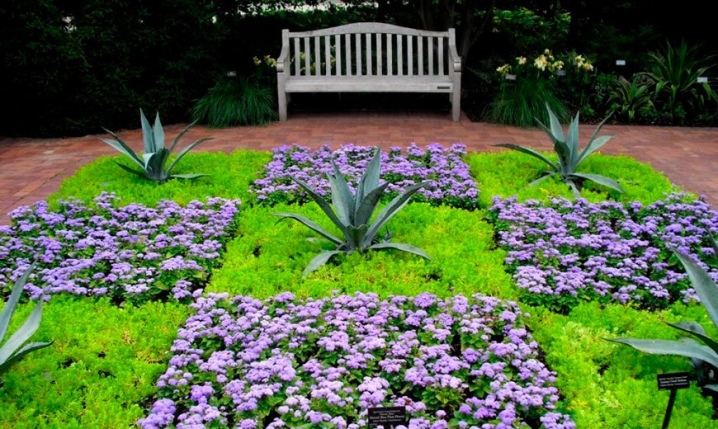
The following video will tell you about the correct cultivation of ageratum.







































































































The comment was sent successfully.